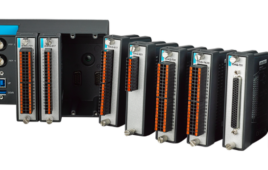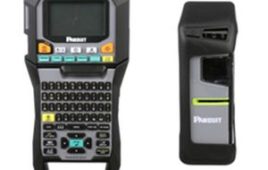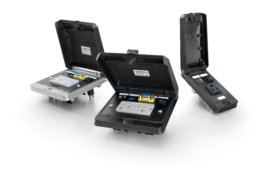By Ed Spence, Managing Director, The Machine Instrumentation Group LLC
Analyzing machine vibration as a means of monitoring healthy operation and diagnosis of emerging problems is a relatively mature specialization, long practiced on turbines and motor-pump trains. Condition Monitoring for the factory today is generally implemented by a skilled practitioner equipped with a handheld data-logger, collecting and processing signals from a tethered vibration sensor during a periodically scheduled, route-based maintenance program. Both time and frequency based signal processing by the handheld instrument is analyzed by the specialist, relying on physics-based knowledge of the machine such as type of bearing and rotation rate of the motor shaft.

Figure 1. This is an example of a condition monitoring facility dashboard, showing vibration and other data trends, machine status and diagnostics information. Courtesy AMC Vibro Sp.z.o.o.
Over the last ten years, the emergence and expanded availability of enabling new technologies such as wireless (IoT) networks, advanced analytics (machine learning) and solid state MEMS accelerometers (vibration sensors) has begun to impact the maintenance industry, expanding the practice of Condition Monitoring to more machines, facilities and applications, enabling remote access to cloud based data dashboards showing machine health conditions and trends, Figure 1.
That said, we are just scratching the surface — many mission critical machines are still not monitored to provide early warning of emerging faults, which consumes time, energy and money for unscheduled maintenance and production downtime. There are many reasons for this: monitoring systems can be costly to install, may lock in the end user (plant maintenance) to the vendor service, getting IT involved can be a headache, and wireless networks raise concerns about data security and liability for known problems.
Further, some machines do not lend themselves to traditional approaches developed for rotating equipment like turbines, induction motors and pumps. Machines with complex movement, operating in noisy environments, or that do not revolve at a fixed speed are not easily diagnosed with commonly used physics-based models and vibration signal analysis methods. Example machines in this category include valves, CNC spindles and ball screws, conveyors motors, mobile equipment, etc.
Emerging industry trends
The next wave of expansion for the Condition Monitoring industry is emerging from the machine makers themselves. Coupling intimate knowledge of the machine fault modes with new sensor technologies, an expanded choice of data connections and advanced analytics, the necessary tools and techniques are now available to the machine OEM, enabling the application of specialized new instrumentation to their own machines for the green field (new installations). The vision is that key aspects of the machine ‘tribal knowledge’ may be automated, relieving customers and field maintenance of the more routine aspects of condition monitoring — detecting and flagging emerging faults — leaving more time for advanced analysis and diagnostics, all with the potential to add recurring revenue from monitoring services to the OEM support model.
What are some of the obstacles inhibiting the R&D team at the machine maker from accelerating their own machine health program or adopting available condition monitoring technologies?
To start with, the current set of tools (sensors, data acquisition and signal processing) are almost all designed and developed to be used in the brown field, that is, installed after-market on equipment already in the facility. These ‘general purpose’ condition monitoring systems and tools can be effective for machines rotating at fixed frequencies such as induction motors and pumps, and often leverage existing OT infrastructure such as PLC’s or SCADA.
But adapting these technologies and approaches to the machine maker context is a process that requires a range of competencies which are often in short supply within the machine maker enterprise. Development of an effective program requires expertise in sensor technologies, electro-mechanical design, signal processing and advance data engineering, communications protocols and other IoT infrastructure.

Figure 2. This example of a health indicator trending dashboard displays indicators for a particular set of machines. The indicators were derived with data engineering techniques. Courtesy Predictronics Corp.
Data engineering and health indicators
Let’s start by looking more closely at data engineering, or the art of extracting useful information from the machine data. In this case, we’re interested in applying techniques in data classification, feature extraction and machine learning to develop new machine health indicators that can expand coverage of monitored faults, improve diagnostic resolution, and pave the way to prognostics by offering earlier detection and warning of emerging faults, Figure 2.
Unfortunately, unlike what we generally read concerning artificial intelligence (AI), this process is not practical when attempted in a vacuum, but is most effectively executed in partnership with machine subject matter experts, who are the most knowledgeable regarding the machine physics, operational behaviors and fault modes.
Another set of useful competencies would include sensor deployment, signal processing and networking (IoT).
Accelerometers and vibration signal processing
The most commonly used sensors for Condition Monitoring are accelerometers to measure vibration of the machine, the signal of which is then processed and analyzed to assess machine health trends, and in many cases diagnose particular faults. Vibration sensing with an accelerometer is unlike virtually any other measurand or instrumentation used for process control.

Figure 3. Vibration signal processing such as Time Sequence Averaging (TSA) use high frequency vibration signals to detect emerging faults in bearings or gearbox. Courtesy GPMS Inc.
Vibration signals useful for assessing the health of components such as bearings or gearbox can contain very high frequency components, elevating the design requirements for sensor packaging, mounting, data acquisition, signal processing and data transmission, Figure 3.
High fidelity data acquisition circuits with resolutions from 18 to 24 bits are standard for vibration signal diagnostics. A poorly designed or mounted sensor package can distort or obscure the mechanical vibration signature, limiting the monitoring effectiveness by reducing the amount of time between the detection of an emerging fault and when the machine component fails outright.
IoT and battery life
Connecting and transmitting vibration data to a destination where it can be analyzed and monitored raises another set of challenges. In some cases, the control system designed for the machine is optimized for characteristics such as timing accuracy or low latency. In this case, the data transport channel (bus) may not be able to handle the high frequency vibration signals. Also, the controller may not be provisioned to adequately receive and process the new signals. This limitation is why many condition monitoring systems on the market today attempt to deploy a wireless network in parallel with, but outside of the installed OT infrastructure.
Wireless sensor networks associated with IoT generally transmit sensor information through a gateway to the ‘cloud’ (a server either on or off premises), where the data can be stored, trended or merged with additional information. A variety of processing resources can then be applied, and the results accessed remotely by anyone authorized to access the data (this raises the issue of data security, but that is a topic for another day…).

Figure 4. Battery life of a wireless sensor is typical dominated by the radio transmission time. High frequency vibration signals take longer to transmit than most other instrumentation measurands such as temperature or pressure.
For high frequency content vibration signals, this presents a problem for the wireless sensor. Since the power consumption of a wireless sensor is generally dominated by the radio transmission, reducing the transmission time is an imperative to extend battery life — a low power design challenge for vibration signals with bandwidths in excess of 10kHz, with sampling rates of 30ksps or more, Figure 4.
Lower frequency signals can be processed within the sensor module, at the edge of the network, such that low bandwidth condition indicators are transmitted to the destination, easing channel requirements and preserving battery life, but this limits the utility of the wireless sensor network to basic condition monitoring, with little diagnostic capability. Of course, the additional edge network processing consumes power within the signal processor. There is little literature describing the trade offs power budget for these two approaches at this time, and most wireless sensor networks on the market today default to transmitting the entire vibration signal to the cloud for visualizing and processing, with the associated high data rate, long transmission time and power consumption.
New tools, techniques and technologies have opened to door for expanding the art of monitoring machine health by enabling the machine maker to implement their own programs, leveraging their deep tribal knowledge of the machine and offering new services.
Filed Under: Data acquisition + DAQ modules, NEWS • PROFILES • EDITORIALS




